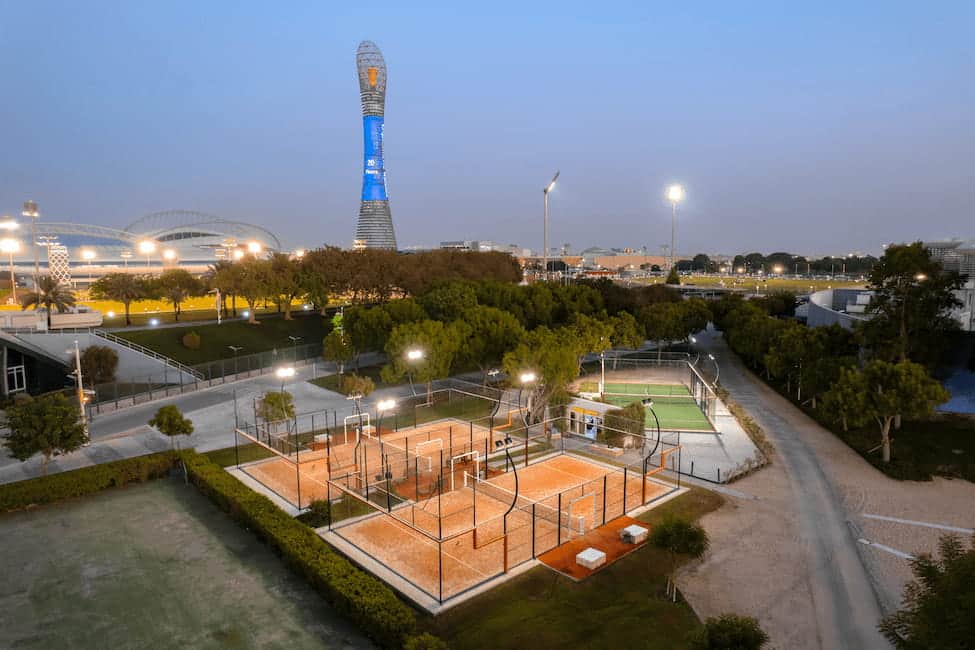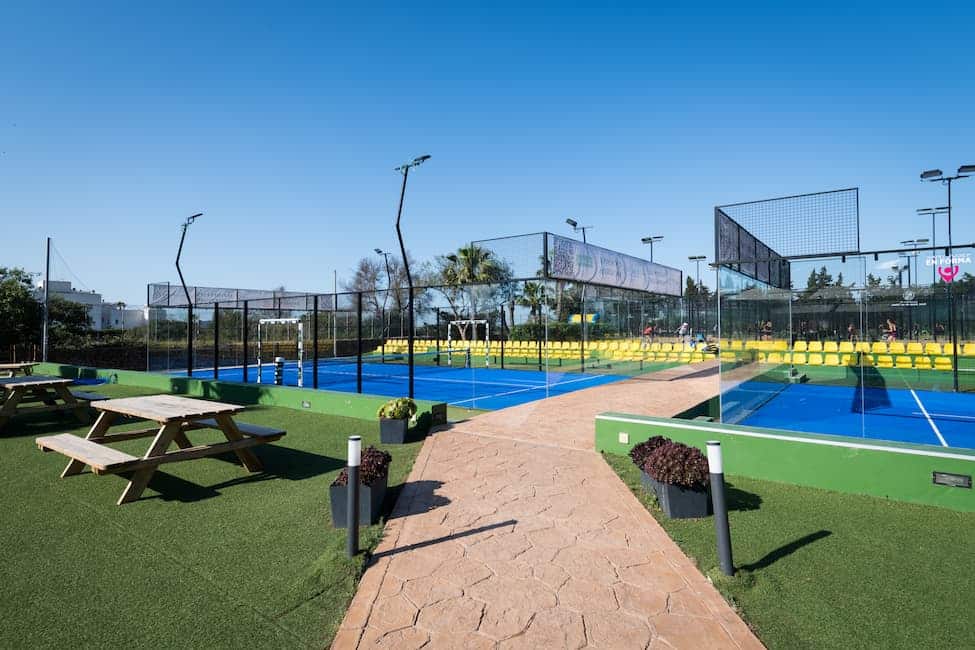Types of Padel Courts and Characteristics

With the significant growth padel is experiencing worldwide, this post provides a brief overview of all the types of padel courts, distinguishing their differences and key aspects that can affect both economic performance and players’ experience.
Types of Padel Courts
Padel shares similarities with tennis but differs significantly in various aspects, reflected in the different types of courts. One fundamental difference is that a padel court can accommodate 4 players simultaneously compared to 2 players in a standard tennis match.
In terms of surface, it immobilizes less than a third of the space. For instance, a tennis court requires approximately 648 m2 of surface area, whereas padel needs a playing surface of 200 m2. This means that for every padel court, up to 3 padel courts can be constructed, allowing for a transition from 2 simultaneous tennis players to accommodating up to 12 players in padel. This exponentially increases the number of club members, generating greater income and resources for padel clubs as a short-term return on investment.
Another significant aspect of padel is its accessibility, as it’s a simpler and less technical game, suitable for a wide range of ages and genders, along with the diverse social backgrounds experiencing this sport, expanding the commercial target.
In conclusion, padel is a globally trending sport that continues to gain popularity and followers.
Indoor and Outdoor Padel Courts
Related to location, padel courts can be categorized as indoor and outdoor. They differ mainly in whether they are located in indoor or outdoor spaces. Each presents different construction characteristics, materials, outer dimensions, and finishes to adapt to weather conditions and the needs of their environment. For example, outdoor padel courts undergo more wear and require more maintenance compared to indoor courts, which are covered and protected.
It’s worth noting that indoor padel courts offer significant advantages, such as players enjoying stable weather conditions without being affected by sun glare. However, this can sometimes lead to a feeling of stuffiness and heat due to the greenhouse effect if the facility is not adequately conditioned. Additionally, indoor courts may limit gameplay dynamics due to the ceiling height.
On the other hand, outdoor padel courts may provide a greater sense of freedom and movement, along with sufficient ventilation and airflow. However, players risk sunburn and being affected by sun glare during matches if they are not prepared to play outdoors. Furthermore, outdoor padel courts require excellent lighting to ensure good visibility for players after sunset.
Types of Padel Courts Based on the Number of Players
Individual Padel Court (1×1)
An individual padel court (1×1) is characterized by much smaller dimensions than a double padel court. They are designed for one-on-one matches. The main difference between an individual padel court and a standard padel court lies in the dimensions. That is, an individual padel court measures 20 meters in length and 6 meters in width, as opposed to the 20 meters in length and 10 meters in width of a double padel court.
Double Padel Court
A double padel court is used in competitions and conventional sports facilities. These courts are characterized by measuring 20 meters in length and 10 meters in width, intended for gameplay between two pairs. These figures represent the official dimensions of a padel court stipulated by official regulatory bodies governing game rules and sports standards.
Types of Padel Courts Based on Playing Surface
Cement Padel Courts
Cement padel courts are characterized by the rigidity of the surface caused by cement, providing a rebound surface that increases game speed. Nowadays, almost all padel courts are equipped with artificial turf as the main pavement. Although the construction of a cement padel court may be much cheaper, the construction of such courts is gradually becoming obsolete.
Artificial Turf Padel Courts
Artificial turf padel courts are predominant worldwide. There is a wide variety of artificial turf types, each providing a different dynamic to the game, slowing down the competition due to the cushioning effect of the artificial turf. Two fundamental types of artificial turf padel courts can be distinguished:
- Monofilament: Higher silica sand infilled and traction.
- Texturized: Lower infill, with the sand barely visible.
Both provide similar playing conditions, differing in the type of sliding they offer. Artificial turf padel courts are used in competitive settings, such as the World Padel Tour or Premier Padel.
Synthetic Resin Padel Courts
Synthetic resin padel courts are a less common alternative in official competition courts, as they require a higher investment cost for installation. These padel courts are characterized in the market by providing good grip and speed in the game.
Types of Padel Courts Based on Structure
Brick/ concrete built Padel Court
Hard built padel courts are usually those that once functioned as tennis courts and have been converted into padel courts. These courts enjoy a hard and rigid surface for ball rebound and provide much more efficient sound insulation. They are a particularly suitable solution in locations and conditions with steep slopes where the walls can serve as load-bearing walls.
Glass Padel Court
Glass padel courts are currently the most popular. Characterized by their refined and elegant aesthetics, they feature glass panels with a thickness of between 10mm and 15mm, allowing players to enjoy a smooth and resistant surface for rebounds, as well as allowing spectators to observe the game inside the court without hindrance.
Three categories of glass panel padel courts can be distinguished:
- Double padel court with tempered glass panel: These courts have glass backgrounds and returns, with panels separated and framed by steel pillars. Typically, they are equipped with tempered glass panels with a thickness of 10 mm.
- Semi-panoramic court: In semi-panoramic padel courts, the backgrounds have no pillars between the glass panels; however, they do have steel corner posts. Typically, the glass panels have a thickness of 12mm.
- Full panoramic padel court: Full panoramic padel courts have completely unobstructed backgrounds, corners, and returns, offering fully panoramic 360º views of the game. Typically, the enclosures of these courts have a thickness of 12 mm. These padel courts are used in both indoor and outdoor competitions.
Recently, in the Premier Padel 2024: Qatar Major, panoramic padel courts were used due to the extensive advantages of this design, allowing spectators to enjoy a panoramic view of the game in competitive environments, as well as on television broadcasts.
We Are Padel Court Manufacturers
In conclusion, there is a wide variety of padel courts to maximize performance in this sport. At Padelgest, we can help you configure the padel court that best suits the needs of each amateur or pro player, padel club, and competition.
We are a specialized and internationally recognized company in the manufacture and installation of high end padel courts for collective sports centers, private facilities, and competitions in various countries. We have installed our solutions on all 5 continents, adapting our high-quality courts to each condition and location. Do not hesitate to contact our team so we can provide you with an excellent quality solution tailored to your needs.


